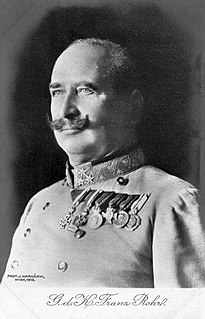This page is based on this
Wikipedia article Text is available under the
CC BY-SA 4.0 license; additional terms may apply.
Images, videos and audio are available under their respective licenses.

The Eastern Front or Eastern Theater of World War I was a theatre of operations that encompassed at its greatest extent the entire frontier between the Russian Empire and Romania on one side and the Austro-Hungarian Empire, Bulgaria, the Ottoman Empire and the German Empire on the other. It stretched from the Baltic Sea in the north to the Black Sea in the south, included most of Eastern Europe and stretched deep into Central Europe as well. The term contrasts with "Western Front", which was being fought in Belgium and France.

The Polish Legions was a name of the Polish military force established in August 1914 in Galicia soon after World War I erupted between the opposing alliances of the Triple Entente on one side ; and the Central Powers on the other side, including the German Empire and Austria-Hungary. The Legions became "a founding myth for the creation of modern Poland" in spite of their considerably short existence; they were replaced by the Polish Auxiliary Corps formation on 20 September 1916, merged with Polish II Corps in Russia on 19 February 1918 for the Battle of Rarańcza against Austria-Hungary, and disbanded following the military defeat at the Battle of Kaniów in May 1918, against imperial Germany. General Haller escaped to France to form the Polish army in the West against the anti-Polish German-Bolshevik treaty.

The 1st Army was a field army-level command in the ground forces of Austria-Hungary during World War I. The army fought in Galicia and Russian Poland in 1914–15 before being briefly dissolved in the summer of 1916. Shortly afterwards, it was reformed and sent to fight in the Romanian Campaign for the next two years. The 1st Army was demobilized in April 1918 due to its heavy losses, following Romania's surrender.

Otto Ernst Vinzent Leo von Below was a Prussian general officer in the Imperial German Army during the First World War. He was most notable for his command, along with the Austro-Hungarian commander Svetozar Boroević, during the victorious Battle of Caporetto.

The Military Order of Maria Theresa was the highest military honour of the Habsburg Monarchy, Austrian Empire and Austro-Hungarian Empire.

The Second Battle of the Isonzo was fought between the armies of the Kingdom of Italy and of Austria-Hungary in the Italian Front in World War I, between 18 July and 3 August 1915.
The Tenth Army was a Field army of the French Army during World War I and World War II.

Viktor Graf von Scheuchenstuel was a Colonel General in the Austro-Hungarian Army. He was a general staff officer and division commander until World War I broke out. During World War I he was a Corps and Army commander serving in Serbia, Albania and Italy. During World War I he was promoted to Graf in the Austrian nobility. Following the end of World War I and the end of the Austro-Hungarian Empire, Scheuchenstuel retired from the military. He died in Vienna.

The Ninth Battle of the Isonzo was an Italian offensive against Austria-Hungary in the course World War I. Including a triumvirate of battles launched after the Italians' successful seizure of Gorizia in August 1916 to extend their bridgehead to the left of the town, it ended in further failure for the Italian Chief of Staff Luigi Cadorna.

The Tenth Battle of the Isonzo was an Italian offensive against Austria-Hungary during World War I.

The Battles of the Isonzo were a series of 12 battles between the Austro-Hungarian and Italian armies in World War I mostly on the territory of present-day Slovenia, and the remainder in Italy along the Isonzo River on the eastern sector of the Italian Front between June 1915 and November 1917.

The 9th Army was an army level command of the German Army in World War I. It was formed in September 1914 in Breslau to command troops on the southern sector of the Eastern Front. The army was dissolved on 30 July 1916, but reformed in Transylvania on 6 September 1916 for the Romanian Campaign. It was transferred to the Western Front on 19 June 1918 where it was finally dissolved on 18 September 1918.
See also:
1916 in Italy,
other events of 1917,
1918 in Italy.

The leaders of the Central Powers of World War I were the political or military figures who commanded or supported the Central Powers during World War I.
The Austro-Hungarian Eleventh Army was an Austro-Hungarian field army that fought during World War I.
The Austro-Hungarian Fifth Army was an Austro-Hungarian field army that fought during World War I.
The Austro-Hungarian Seventh Army was an Austro-Hungarian field army that fought during World War I.
The Austro-Hungarian Fourth Army was an Austro-Hungarian field army that fought during World War I.

The 3rd Army was a field army-level command within the ground forces of Austria-Hungary during World War I. It was primarily active on the Eastern Front against the Russian Empire and in the Balkans against Serbia and Montenegro. Later on, the 3rd Army took part in some fighting on the Italian Front before returning to the eastern theater by 1917 to repulse the Kerensky Offensive. Its remaining units were merged with the 7th Army in January 1918.
The South Tyrolean Army Group was an Army Group of the Austro-Hungarian Army, which operated in South Tyrol against Italy, between 1 March 1917 and the end of the war during World War I. It was also called Army Group Conrad and Army Group Archduke Joseph after its commanders.

















